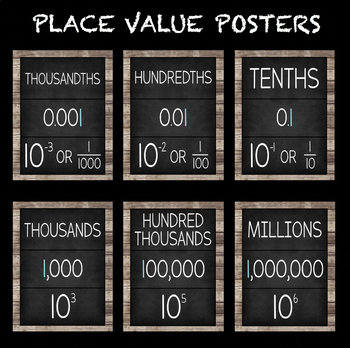Rustic Farmhouse Chalkboard Place Value Posters
Fun in 5th with Mrs H
40 Followers
Grade Levels
K - 12th, Higher Education, Adult Education, Homeschool, Not Grade Specific
Subjects
Resource Type
Standards
CCSS2.NBT.A.1b
CCSS3.NBT.A.2
CCSS4.NBT.A.1
CCSS4.NBT.A.2
CCSS4.NBT.B.5
Formats Included
- Zip
Pages
13 pages
Fun in 5th with Mrs H
40 Followers
Description
These adorable place value posters reinforce the Base 10 nature of place value, highlighting the number of "zero" placeholders simultaneously with the powers of ten! These will be the perfect addition to your rustic farmhouse themed classroom. Values range from thousandths to BILLIONS!
Blow up on poster-size paper, or print on standard paper and laminate.
Enjoy! ~
Total Pages
13 pages
Answer Key
Does not apply
Teaching Duration
N/A
Report this resource to TPT
Reported resources will be reviewed by our team. Report this resource to let us know if this resource violates TPT’s content guidelines.
Standards
to see state-specific standards (only available in the US).
CCSS2.NBT.A.1b
The numbers 100, 200, 300, 400, 500, 600, 700, 800, 900 refer to one, two, three, four, five, six, seven, eight, or nine hundreds (and 0 tens and 0 ones).
CCSS3.NBT.A.2
Fluently add and subtract within 1000 using strategies and algorithms based on place value, properties of operations, and/or the relationship between addition and subtraction.
CCSS4.NBT.A.1
Recognize that in a multi-digit whole number, a digit in one place represents ten times what it represents in the place to its right. For example, recognize that 700 ÷ 70 = 10 by applying concepts of place value and division.
CCSS4.NBT.A.2
Read and write multi-digit whole numbers using base-ten numerals, number names, and expanded form. Compare two multi-digit numbers based on meanings of the digits in each place, using >, =, and < symbols to record the results of comparisons.
CCSS4.NBT.B.5
Multiply a whole number of up to four digits by a one-digit whole number, and multiply two two-digit numbers, using strategies based on place value and the properties of operations. Illustrate and explain the calculation by using equations, rectangular arrays, and/or area models.





